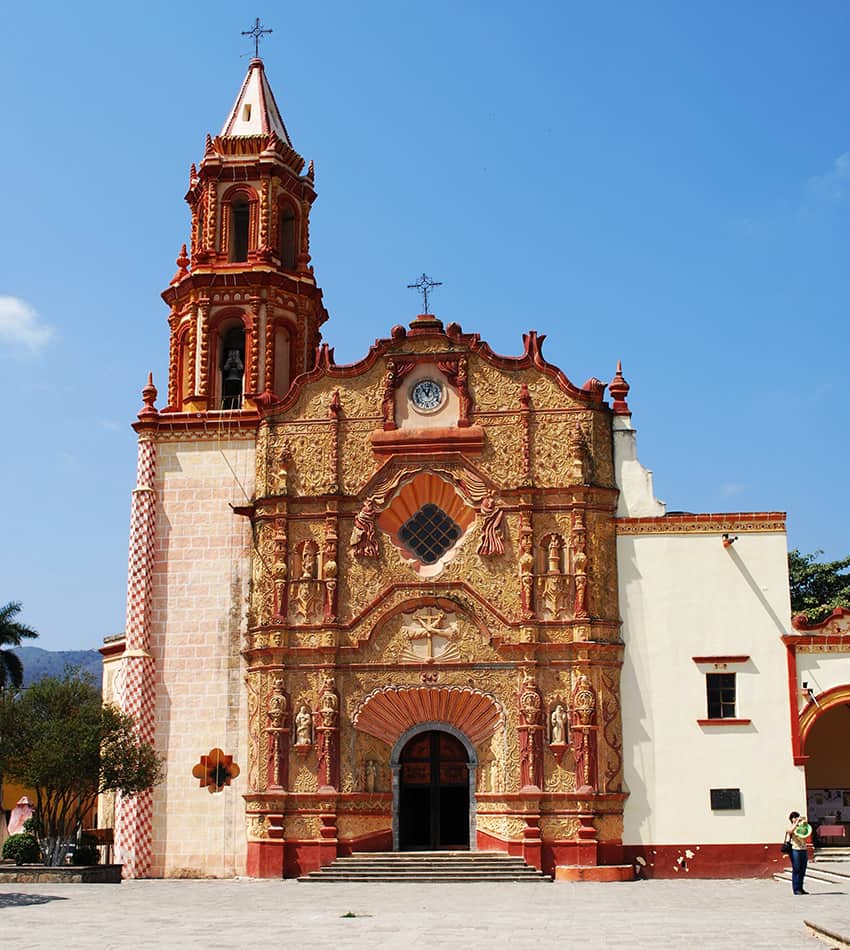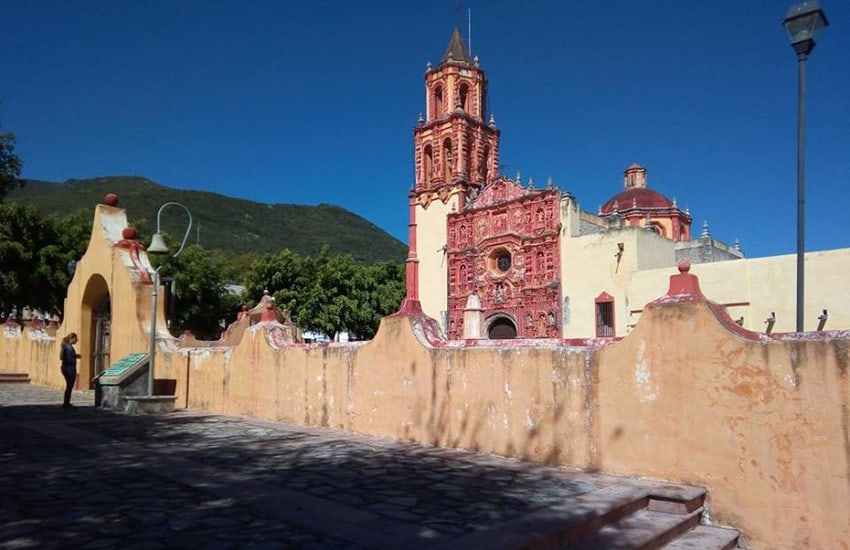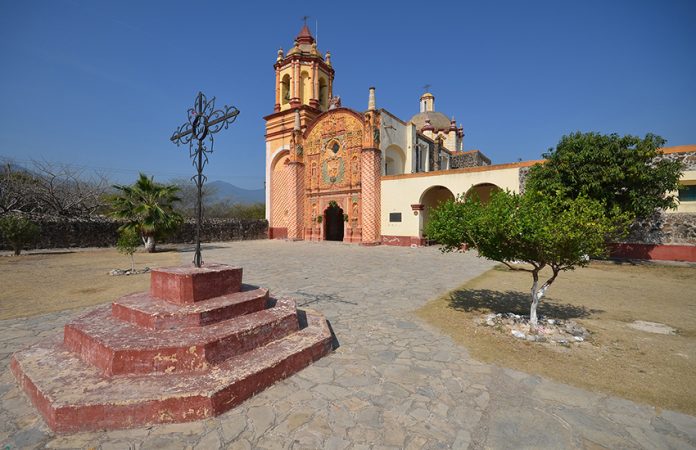If you are familiar with the missions that extend from Baja California all the way up to San Francisco, you might very well know the name of Friar Junípero Serra. But his mission story did not begin in the Californias. It began in a forgotten but beautiful corner of central Mexico.
The Sierra Gorda region covers the northern half of the state of Querétaro with bits in the neighboring states of Guanajuato and Hidalgo. Now, as then, the area has been the gateway from Mesoamerica to what is called Aridoamerica (northern Mexico into the United States).
Heading north from the state capital, the region and declared biosphere begins in a municipality called Peñamiller. It is filled with microclimates, ranging from the intensely hot and dry to the pine and holm oak forests that dominate to a tiny area that is rainforest.
The towns and villages that existed before the biosphere declaration still exist and continue with their traditional ways of life. Among these towns are five small Baroque churches that look not too different from rural parish churches in central Mexico. They have highly ornate facades, with spiraling columns, profuse vegetal decoration, saints, angels and other Catholic iconography.
But there are important differences in themes and coloring that give testament to a major shift in how evangelizing monks did their work as they pushed north in the mid-18th century.

In the early colonial period, the Spanish government and Catholic Church simply took over existing Mesoamerican social structures and modified them to their liking. Mesoamerican communities were already “civilized” in the sense that they were accustomed to a rigidly hierarchical, sedentary society where religion and government were intertwined, each justifying the other.
Their cosmology was reinvented but not so much their day-to-day lives.
In Aridoamerica, nomadic and semi-nomadic peoples dominated. What few large cities that existed in this region had disappeared long before the Conquest. The colonial Spanish had no qualms about using brute force, but prior experiences (especially in Michoacán) had shown that such force could actually backfire.
The first Aridoamerican peoples the Spanish encountered included the Pames, Ximpeces, Chichimecas and Huastecos, who strongly resisted domination because it not only meant a religious conversion but a complete change in their way of life.
Without an empire system to co-opt, Junípero Serra and the Franciscans decided to introduce the idea of “sedentary civilization” by creating mission churches as centers of the new order. The first five were constructed in the Sierra Gorda, in what are now the communities of Concá, Jalpan, Tancoyol, Agua de Landa and Tilaco.
The strategies developed here included learning the local languages to preach in, building the mission church and other structures using indigenous labor, making sure that the population was fed and somewhat protected from the worst of Spanish abuses and teaching skills such as farming and trades.
They are similar to those practices promoted by Friar Bartolomé de las Casas in Chiapas and Vasco de Quiroga, the first Catholic bishop in Michoacán, to great success.
These five mission churches look much like their counterparts farther south because Baroque architecture was still in fashion and because mining provided money for more ornate structures. As the Spanish headed north, mission churches would be progressively simpler, including the California mission style that is highly popular in the western United States today.
But these ornate churches demonstrate the layering of Catholic beliefs over indigenous ones that later churches do not.
The facades, in particular, were highly decorated as a means of teaching concepts. In addition to images of saints, angels, demons, etc., these churches also have images important to the cosmology of the original indigenous population, in particular certain animals and plants.
The most important of the five churches was built in Jalpan starting in 1751, and Jalpan is still the most important community in the area today. Its facade contains a two-headed eagle eating a serpent, reminiscent of the eagle and serpent symbol representing both the Aztecs and Mexico today.
The Concá church contains images of rabbits, which were important to the Pames as a symbol of the lunar calendar and the change of seasons. The Tancoyol church’s portal contains the image of a jaguar among the various European mascarons. The Tilaco church is heavily decorated with local vegetation, both wild and cultivated.

Such co-opting is nothing new. Evangelists have used similarities between native religions and Christianity since evangelicalism began.
These five churches, and many more that came after, became the basis of towns and cities in areas that did not have them previously. However, starting in 1770, mission churches came under the control of regular clergy as indigenous populations dwindled and were replaced by those of Spanish and mixed heritage.
No longer needed for evangelization, the churches’ decorations deteriorated. In the tumultuous century following Mexico’s independence, this process accelerated with sacking of churches and other destruction.
The first five mission churches returned to Mexico’s collective memory with work done by researcher Monique Gustín, who published El barroco en la Sierra Gorda (The Baroque in the Sierra Gorda) in 1969. In the 1970s, the National Institute of History and Anthropology (INAH) began to urge the conservation of these Querétaro churches.
In the 1980s and 1990s, INAH collaborated with the state government to restore them, especially the main portals and bell towers. And in the very late 20th century, Dr. Miguel León Portialla of the National Autonomous University began a campaign to have the five declared a World Heritage Site, stressing the missions’ role in Serra’s work.
He succeeded, and the five are listed under the name Franciscan Missions in the Sierra Gorda of Querétaro.
As for Junípero Serra, he worked in Sierra Gorda for eight years before returning to Mexico City and then moving on to the Californias. He died in what is now Carmel Valley, California.
He is honored in many places where he worked and was beatified by the church despite objections by Native American groups.
Leigh Thelmadatter arrived in Mexico 18 years ago and fell in love with the land and the culture in particular its handcrafts and art. She is the author of Mexican Cartonería: Paper, Paste and Fiesta (Schiffer 2019). Her culture column appears regularly on Mexico News Daily.
